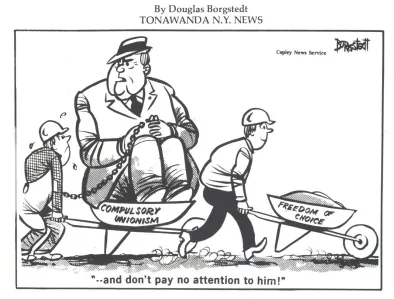Right to Work States Have Superior Job Growth

Compensation of employees by industry (SA06, SA06N)

All of the 10 bottom-ranking states for total 2001-2011 private-sector job creation lacked Right to Work protections for employees. Overall, Right to Work states' employment growth was nine percentage points greater than that of forced-unionism states.
On September 25, 2011, the U.S. Commerce Department’s Bureau of Economic Analysis (BEA) issued its estimates for total 2011 private-sector, nonfarm employment in the 50 states.
The BEA simultaneously issued revised data for overall state personal income and an array of specific kinds of income, including employee compensation in the form of wages, salaries, benefits and bonuses.
The 2011 BEA employment and income data show once again that there is a strong negative correlation between compulsory unionism and economic growth.
Nationwide, private-sector, nonfarm employment as reported by the BEA grew by 6.9% from 2001 to 2011. (Unlike the establishment jobs data published by the U.S. Labor Department’s Bureau of Labor Statistics, BEA data track self-employment and contractual employment as well as payroll jobs.) Historically, this was a very weak gain.
However, states that protect employees from being fired for refusal to pay dues or fees to an unwanted union typically fared far better than the rest. From 2001 to 2011, 22 states had Right to Work laws prohibiting forced union dues on the books. Early this year Indiana became the 23rd Right to Work state.
All of the top five, and 10 of the top 12, states for 2001-2011 private-employment growth are Right to Work states. Meanwhile, the 10 bottom-ranking states for employment growth all lacked Right to Work statutes at the time.
Overall, BEA-reported private-sector, nonfarm employment grew by 12.5% over the past decade. That’s well over triple the average for forced-unionism states, and nearly double the national average. (See the first link above for more details.)
And workers in forced-unionism states suffer from lower compensation growth as well as fewer job opportunities.
From 2001 to 2011, inflation-adjusted private-sector compensation increased by 12.0% in Right to Work states. That’s double the national average and quadruple the forced-unionism state average. (See the second link above for more information. The BEA data are adjusted for inflation using the Labor Department’s CPI-U indicator.) Sixteen of the 17 bottom-ranking states for compensation growth lacked Right to Work laws during the first decade of the millennium.

